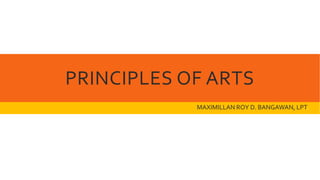
Principles of Arts
- 1. PRINCIPLES OF ARTS MAXIMILLAN ROY D. BANGAWAN, LPT.
- 2. WHAT IS ORGANIZATION? Organization refers to the “order” in a work of art. I refers to the ways elements are arranged, combined, and configured to make a whole.
- 3. ORGANIZATION INTHEVISUAL ARTS •Rhythm – can be described as timed movement through space; an easy, connected path along which the eye follows a regular arrangement of motifs.
- 5. Emphasis – also referred to as point of focus, or interruption which strongly draw the viewer’s attention.
- 7. Unity – the underlying principle that summarizes all of the principles and elements of design.
- 9. Balance – is the condition or quality which gives a feeling of rest, repose, equilibrium or stability. 3 main types: 1.Symmetrical balance – can be described as having equal “weight” on equal sides of a centrally placed fulcrum. 2.Asymmetrical Balance – also called informal balance, is more complex and difficult to envisage. 3. Radial Balance – Repetition of images evenly from the center outward.
- 11. Proportion – is the principle which shows the pleasing relationship between a whole and its parts and between the parts themselves.
- 13. • Movement - can apply to a single component in a composition or to the whole composition at once. Visual movement is dependent on the other elements and principles of art. Rhythm, line, color, balance and space are all examples of elements and principles of art that can play a major role in developing movement in a work of art.
- 15. • Harmony - is the principle of art that creates cohesiveness by stressing the similarities of separate but related parts. One should note that harmony is not the same as unity. Harmony does, however, enhance unity in a work of art. Specifically, harmony uses the elements of art (color, line, shape, form, value, space, texture) as a vehicle to create a sense of togetherness amongst otherwise separate parts.
- 17. • Variety - is the principle of art that adds interest to an artwork. Variety works through juxtaposition and contrast. When an artist places different visual elements next to one another, he/she is using variety. Straight lines next to curvy lines add variety. Organic shapes among geometric shapes add variety. Bright colors next to dull colors add variety. Note: If an artist uses variety to draw the viewers attention to a specific area in a composition then variety morphs into emphasis, also a principle of art. Principles of art bleed into one another. They overlap.